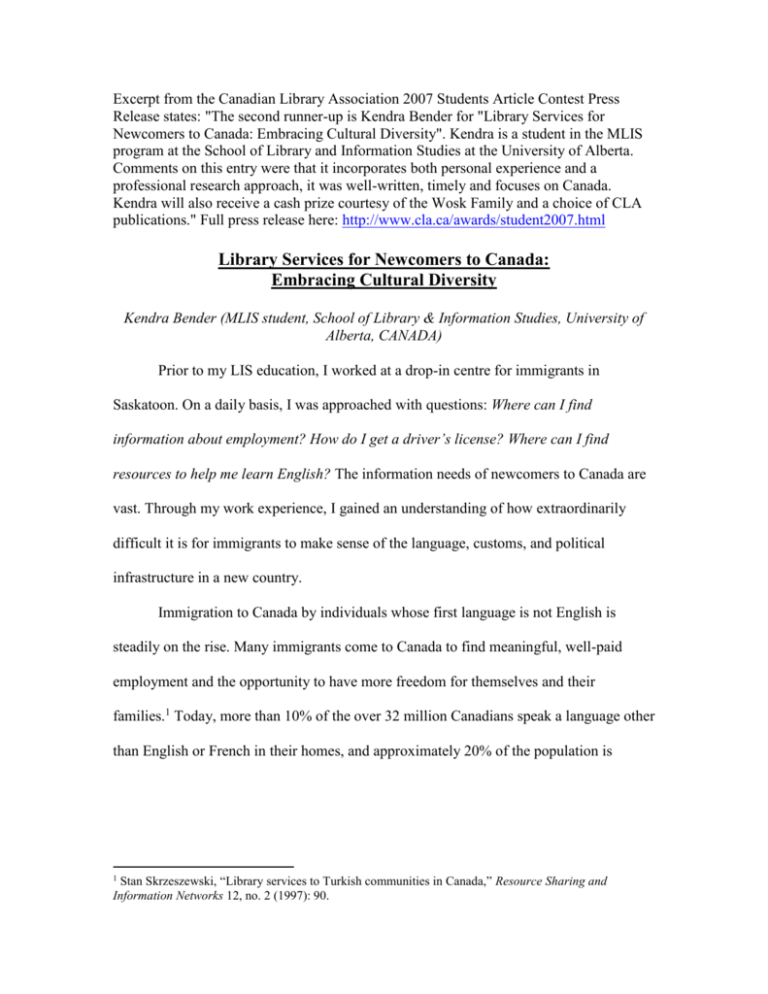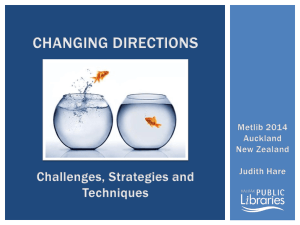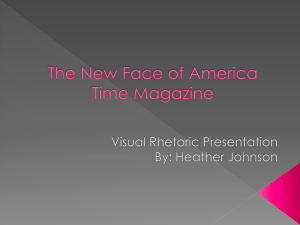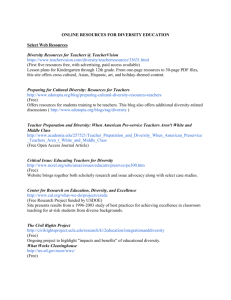Library Services for Newcomers to Canada
advertisement

Excerpt from the Canadian Library Association 2007 Students Article Contest Press Release states: "The second runner-up is Kendra Bender for "Library Services for Newcomers to Canada: Embracing Cultural Diversity". Kendra is a student in the MLIS program at the School of Library and Information Studies at the University of Alberta. Comments on this entry were that it incorporates both personal experience and a professional research approach, it was well-written, timely and focuses on Canada. Kendra will also receive a cash prize courtesy of the Wosk Family and a choice of CLA publications." Full press release here: http://www.cla.ca/awards/student2007.html Library Services for Newcomers to Canada: Embracing Cultural Diversity Kendra Bender (MLIS student, School of Library & Information Studies, University of Alberta, CANADA) Prior to my LIS education, I worked at a drop-in centre for immigrants in Saskatoon. On a daily basis, I was approached with questions: Where can I find information about employment? How do I get a driver’s license? Where can I find resources to help me learn English? The information needs of newcomers to Canada are vast. Through my work experience, I gained an understanding of how extraordinarily difficult it is for immigrants to make sense of the language, customs, and political infrastructure in a new country. Immigration to Canada by individuals whose first language is not English is steadily on the rise. Many immigrants come to Canada to find meaningful, well-paid employment and the opportunity to have more freedom for themselves and their families.1 Today, more than 10% of the over 32 million Canadians speak a language other than English or French in their homes, and approximately 20% of the population is Stan Skrzeszewski, “Library services to Turkish communities in Canada,” Resource Sharing and Information Networks 12, no. 2 (1997): 90. 1 2 foreign-born.2 However, despite the growing number of immigrants to Canada, average expenditures for multilingual materials in Canadian libraries are less than 2%.3 It takes time for emerging immigrant communities to “get organized, have a presence and make their needs known to public institutions”, but libraries can identify and communicate with these populations through immigrant advocacy organizations.4 The agency that I worked for, for example, often provides a link between newcomers and the public library. Library tours are incorporated into programming and librarians are invited to the drop-in centre to speak about information services and local history. Surrey Public Library, which serves a community of 56 ethnic groups, anticipated a growth of ethnic communities nearly 20 years ago.5 They created a “vision of the Library as an inclusive and vibrant reflection of the community” by forming working relationships with local multicultural agencies and leaders from ethnic groups, hiring individuals with a variety of language skills, and conducting cross-cultural workshops for all staff.6 These actions reflect CLA’s Library Services to Linguistic and Ethnic Minorities position statement, which recognizes that libraries have a unique and necessary role to promote “cross-cultural understanding in the interest of a harmonious and integrated society”.7 This statement also advocates that libraries should “reflect the Mijin Kim, “Introducing Multicultural Resources and Services at Library and Archives Canada,” Feliciter 50, no. 1 (2004): 19; Statistics Canada, “Population by year, province and territory,” Statistics Canada, http://www40.statcan.ca/l01/cst01/demo02a.htm (accessed March 29, 2007). 3 Stan Skrzeszewski, “From multiculturalism to cosmopolitanism: world fusion and libraries,” Feliciter 47, no. 4 (2001): 15. 4 Chryss Mylopoulos, “New Faces on the Block: Emerging Immigrant Communities and How to Identify Them,” Feliciter 50, no. 1 (2004): 12. 5 Wendy Jang et al., “Cross Canada Checkup: Multicultural Services in Public Libraries,” Feliciter 50, no. 1 (2004): 26. 6 Ibid., 26. 7 Canadian Library Association, “Library Services to Linguistic and Ethnic Minorities,” Canadian Library Association, http://www.cla.ca/about/minor.htm (accessed March 29, 2007). 2 3 multicultural nature of Canadian society as is appropriate to the collections and services provided for their client groups”.8 One of the most ethnically diverse cities in Canada is Richmond, B.C. with an immigrant population of about 54%.9 To develop services to meet the needs of this growing multicultural community, Richmond Public Library (RPL) established a Multilingual Services Department in 2000.10 RPL strongly supports the notion of community partnerships, which help to promote library services and allow for resourcesharing in the offering of programs.11 Many multilingual programs and services were introduced at RPL including a new immigrant orientation program, an employment trends series, and ESL conversation circles.12 Similarly, Edmonton Public Library (EPL) recently posted a Multicultural Community Development Intern position designed to help meet the needs of significant immigrant populations, and to increase the awareness and use of the library’s collection among these communities.13 For immigrants whose first language is not English, the ability to understand services offered in libraries and to express themselves in either of the official languages varies from person to person.14 Some people may not be familiar with library terminology, or know how to ask appropriate questions of library staff.15 However, these individuals share the same right to access information with others whose language skills 8 Ibid. Jang et al., 26. 10 Wendy Jang, “Multilingual Services at Richmond Public Library,” Feliciter 49, no. 3 (2003): 158. 11 Jang et al., 26; Jang, 158-159. 12 Jang, 159. 13 Edmonton Public Library, “Job Posting,” Edmonton Public Library, http://www.epl.ca/EPLJobPostingNo.cfm?id=IO-01-07 (accessed March 29, 2007). 14 Usha Prasada-Kole, “Library services to Indians living abroad, specifically in Canada,” Resource Sharing and Information Networks 11, no. ½ (1996): 111. 15 Ibid., 111. 9 4 are more proficient.16 The CLA Library Services to Linguistic and Ethnic Minorities position statement mirrors this sentiment: “all citizens of Canada should have equitable access to library materials and services which will meet their needs regardless of their language [or] cultural background”.17 Outside of Canada, equal access to information by immigrants has recently been strongly reinforced by a resolution passed at the American Library Association (ALA) mid-winter meeting in Seattle. The resolution boldly states that the U.S. library community “opposes all attempts at the local, state and federal level to restrict access to information by immigrants” and “supports the protection of each person's civil liberties, regardless of that individual's nationality, residency, or status”. 18 At the public library in Saskatoon, I would often encounter the newcomers I had met through my job. Many would be with their children; others would be using the public computers. I would see the same individuals on numerous occasions, so I sensed that visits to the library were part of their routine. In 2001, 30% of non-native Canadians used the Toronto Public Library (TPL) weekly, which was more than double the rate of library use by native-born Canadians.19 The same year, TPL’s multilingual circulation increased by 28%, reaching 12% of total circulation.20 34 of the 40 languages collected at TPL were spoken by staff with collection responsibilities and library pages were recognized as one of their “great untapped resources” to compensate for some of the remaining 16 Ibid., 111. Canadian Library Association. 18 American Library Association, “ALA Council passes resolution in support of immigrant rights to access to information,” American Library Association, http://www.ala.org/ala/pressreleases2007/february2007/irr07.htm (accessed March 29, 2007). 19 Norman Order, “Growing into a Changing City,” Library Journal 128, no. 10 (2003): 41. 20 Ibid., 41. 17 5 language gaps.21 However, collection development can be challenging for multicultural communities, as newcomers may move many times within Canada before they settle.22 To help public libraries improve collections and services for Russian immigrants in Toronto, Dali (2004) conducted a study of the reading habits of this population. Unfortunately, the majority of respondents sampled in her survey were not satisfied with the collection of Russian-language books in their public libraries. However, the public library was characterized as a “place to spend time”, where English language materials about the history and customs of their new country could be accessed for free.23 Accessing materials for free was a theme that reoccurred in Dali’s research. Improved income did not seem to reduce the respondents’ inclination to use the public library for acquiring desired Russian-language titles (if available), precisely because they were offered at no cost.24 To develop multilingual collections, librarians need “professional curiosity, an ambition to build [a multilingual] collection best suited to the users and knowledge of the language for which one is developing a collection”.25 Libraries must know the community for whom the collection is being developed and listen to its members, recognizing that immigrant communities may be “well informed about the latest titles, authors and popular trends in…contemporary literature”.26 Although recent library research related to immigrants in Canada seems to be limited, several themes are evident: public libraries are being called to recognize the 21 Ibid., 42. Ibid., 42. 23 Keren Dali, “Reading by Russian-speaking immigrants in Toronto: use of public libraries, bookstores, and home book collections,” 36, no. 4 (2004): 353-4. 24 Ibid., 354-355. 25 Ibid., 357. 26 Ibid., 357. 22 6 realities of multiculturalism, provide cross-cultural training for existing librarians and support staff, employ a diverse workforce, and develop partnerships with immigrant and ethnic organizations for resource-sharing and understanding. Many immigrants suffer from information poverty by not having ready access to historical or contemporary materials in their first languages, or by not possessing the ability to fully understand the many English-language materials offered by public libraries. Nonetheless, it is clear that many immigrants are using the public library frequently to support their adjustment to life in Canada. In response, the library community must continue to embrace cultural diversity and strive to equitably meet the needs of multi-ethnic populations. Bibliography American Library Association, “ALA Council passes resolution in support of immigrant rights to access to information,” American Library Association, http://www.ala.org/ala/pressreleases2007/february2007/irr07.htm Canadian Library Association, “Library Services to Linguistic and Ethnic Minorities,” Canadian Library Association, http://www.cla.ca/about/minor.htm Dali, Keren. “Reading by Russian-speaking immigrants in Toronto: use of public libraries, bookstores, and home book collections.” International Information and Library Reviews 36, no. 4 (2004): 341-66. Edmonton Public Library, “Job Posting,” Edmonton Public Library, http://www.epl.ca/EPLJobPostingNo.cfm?id=IO-01-07 Jang, Wendy. “Multilingual Services at Richmond Public Library.” Feliciter 49, no. 3 (2003): 158-60. 7 Jang, Wendy, et al. “Cross Canada Checkup: Multicultural Services in Public Libraries.” Feliciter 50, no. 1 (2004): 26-27. Kim, Mijin. “Introducing Multicultural Resources and Services at Library and Archives Canada.” Feliciter 50, no. 1 (2004): 19-20. Mylopoulos, Chryss. “New Faces on the Block: Emerging Immigrant Communities and How to Identify Them.” Feliciter 50, no. 1 (2004): 12-13. Order, Norman. “Growing into a Changing City.” Library Journal 128, no. 10 (2003): 40-42. Prasada-Kole, Usha. “Library services to Indians living abroad, specifically in Canada.” Resource Sharing and Information Networks 11, no. ½ (1996): 107-24. Statistics Canada, “Population by year, province and territory,” Statistics Canada, http://www40.statcan.ca/l01/cst01/demo02a.htm Skrzeszewski, Stan. “From multiculturalism to cosmopolitanism: world fusion and libraries.” Feliciter 47, no. 4 (2001): 14-16. Skrzeszewski, Stan. “Library services to Turkish communities in Canada.” Resource Sharing and Information Networks 12, no. 2 (1997): 89-93.







